Strategic Report: Tesco's Competitive Advantage and Growth Strategy
VerifiedAdded on 2023/06/07
|16
|4851
|301
Report
AI Summary
This report provides a comprehensive strategic analysis of Tesco, a multinational grocery retailer in the UK. It begins with a PESTLE and SWOT analysis to evaluate the external and internal environments, respectively, and then analyzes Tesco's resources and capabilities using VRIO framework. The report uses Porter's Five Forces model to assess the competitive landscape and identifies the bargaining power of buyers as a significant challenge. The McKinsey 7S model is applied to determine existing and potential competitive advantages, focusing on both hard and soft elements within the organization. Furthermore, the report explores varied types of strategic directions and suggests the most appropriate growth platform and strategy for Tesco, along with ways to monitor its success. The analysis emphasizes the importance of enhancing Tesco's online presence and product quality to maintain a competitive edge in the market.
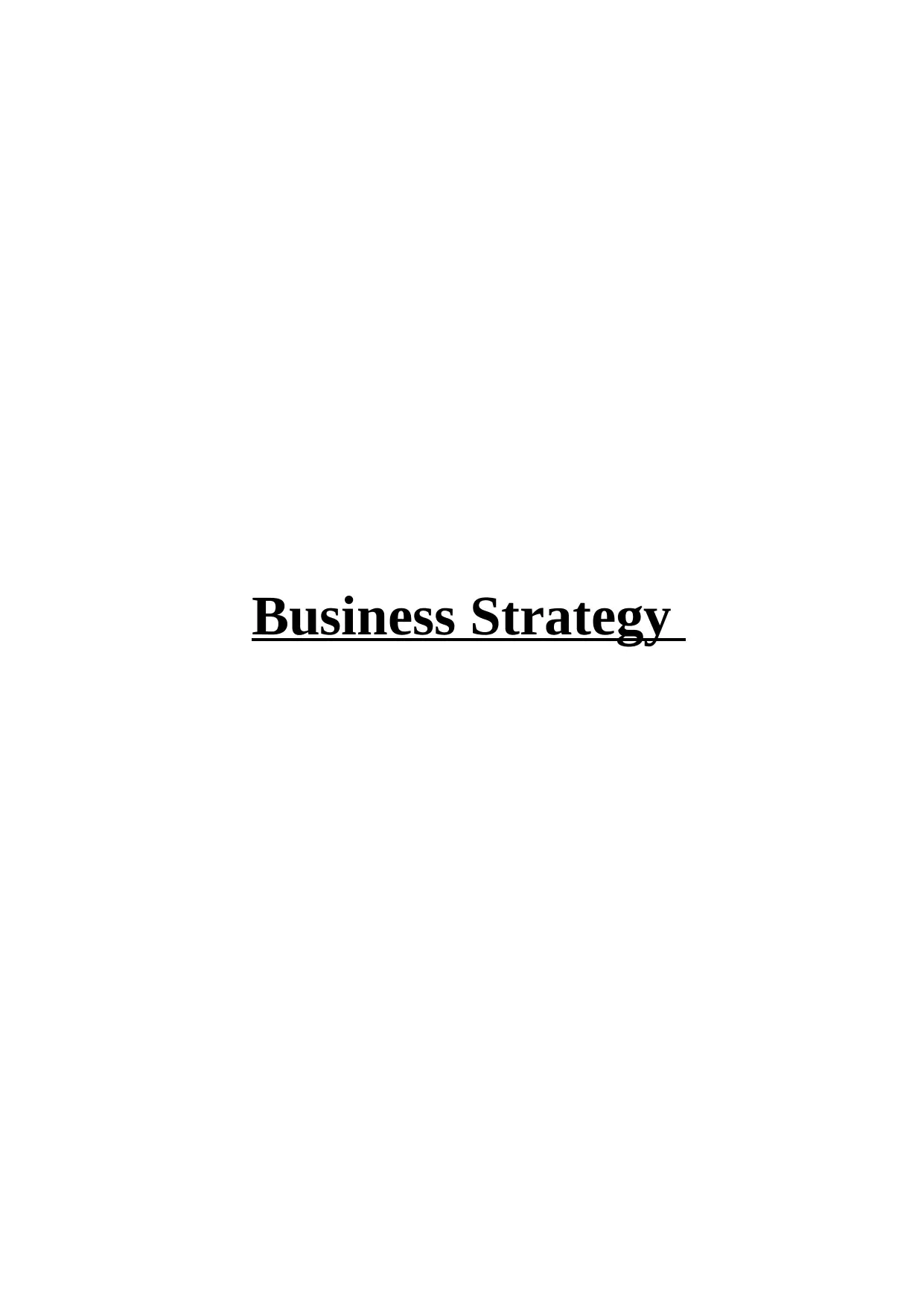
Business Strategy
Paraphrase This Document
Need a fresh take? Get an instant paraphrase of this document with our AI Paraphraser
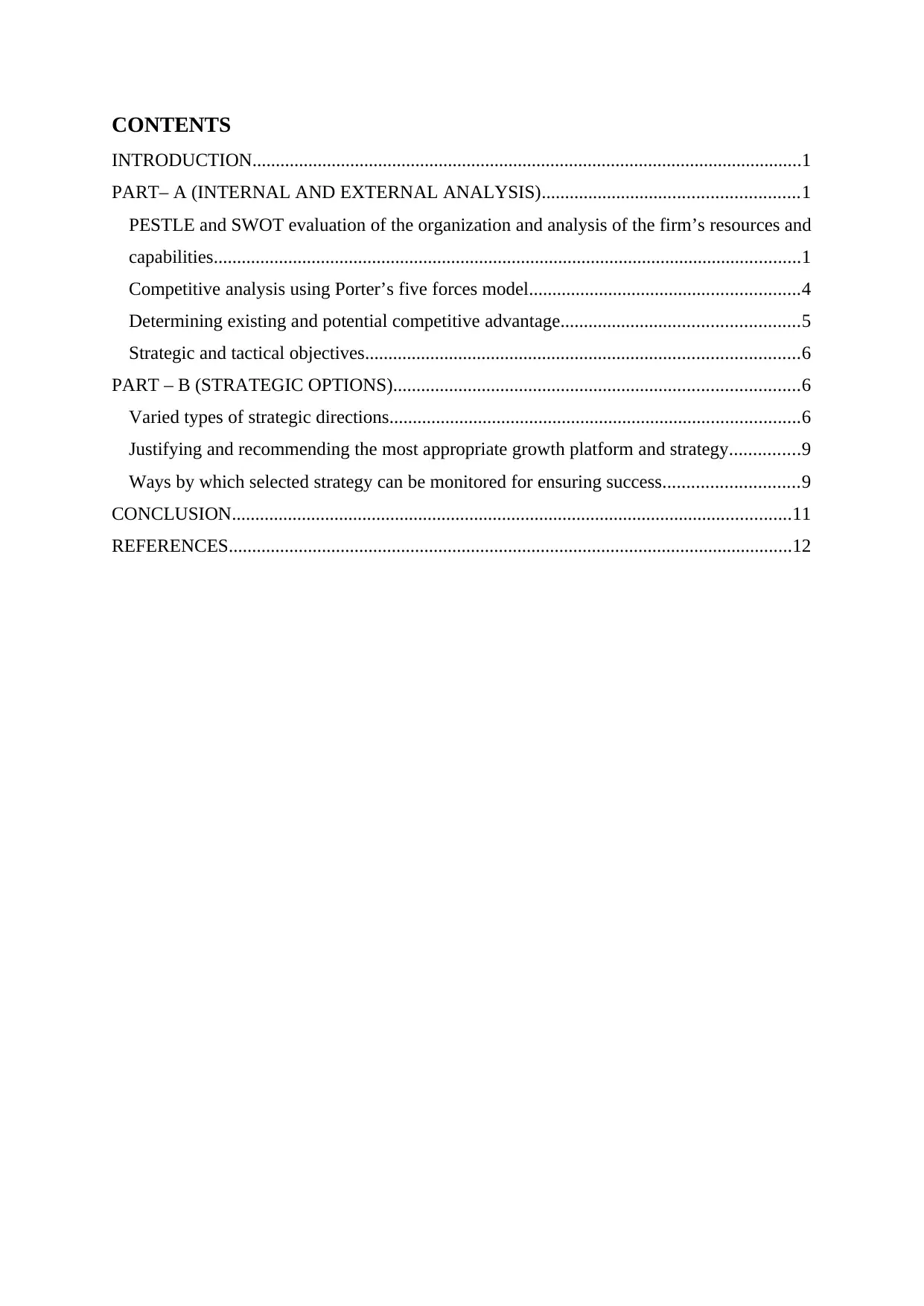
CONTENTS
INTRODUCTION......................................................................................................................1
PART– A (INTERNAL AND EXTERNAL ANALYSIS).......................................................1
PESTLE and SWOT evaluation of the organization and analysis of the firm’s resources and
capabilities..............................................................................................................................1
Competitive analysis using Porter’s five forces model..........................................................4
Determining existing and potential competitive advantage...................................................5
Strategic and tactical objectives.............................................................................................6
PART – B (STRATEGIC OPTIONS).......................................................................................6
Varied types of strategic directions........................................................................................6
Justifying and recommending the most appropriate growth platform and strategy...............9
Ways by which selected strategy can be monitored for ensuring success.............................9
CONCLUSION........................................................................................................................11
REFERENCES.........................................................................................................................12
INTRODUCTION......................................................................................................................1
PART– A (INTERNAL AND EXTERNAL ANALYSIS).......................................................1
PESTLE and SWOT evaluation of the organization and analysis of the firm’s resources and
capabilities..............................................................................................................................1
Competitive analysis using Porter’s five forces model..........................................................4
Determining existing and potential competitive advantage...................................................5
Strategic and tactical objectives.............................................................................................6
PART – B (STRATEGIC OPTIONS).......................................................................................6
Varied types of strategic directions........................................................................................6
Justifying and recommending the most appropriate growth platform and strategy...............9
Ways by which selected strategy can be monitored for ensuring success.............................9
CONCLUSION........................................................................................................................11
REFERENCES.........................................................................................................................12
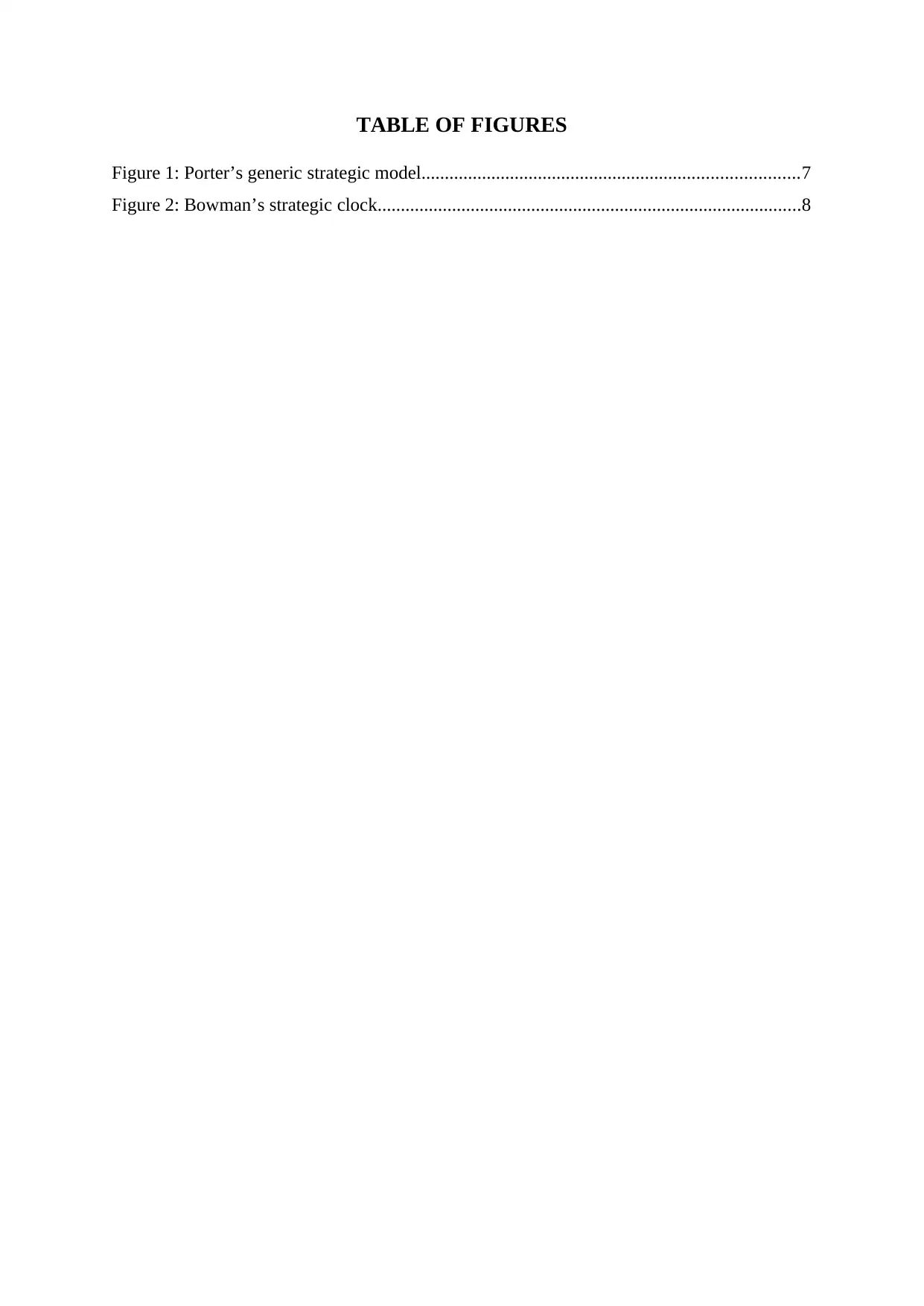
TABLE OF FIGURES
Figure 1: Porter’s generic strategic model.................................................................................7
Figure 2: Bowman’s strategic clock...........................................................................................8
Figure 1: Porter’s generic strategic model.................................................................................7
Figure 2: Bowman’s strategic clock...........................................................................................8
⊘ This is a preview!⊘
Do you want full access?
Subscribe today to unlock all pages.

Trusted by 1+ million students worldwide
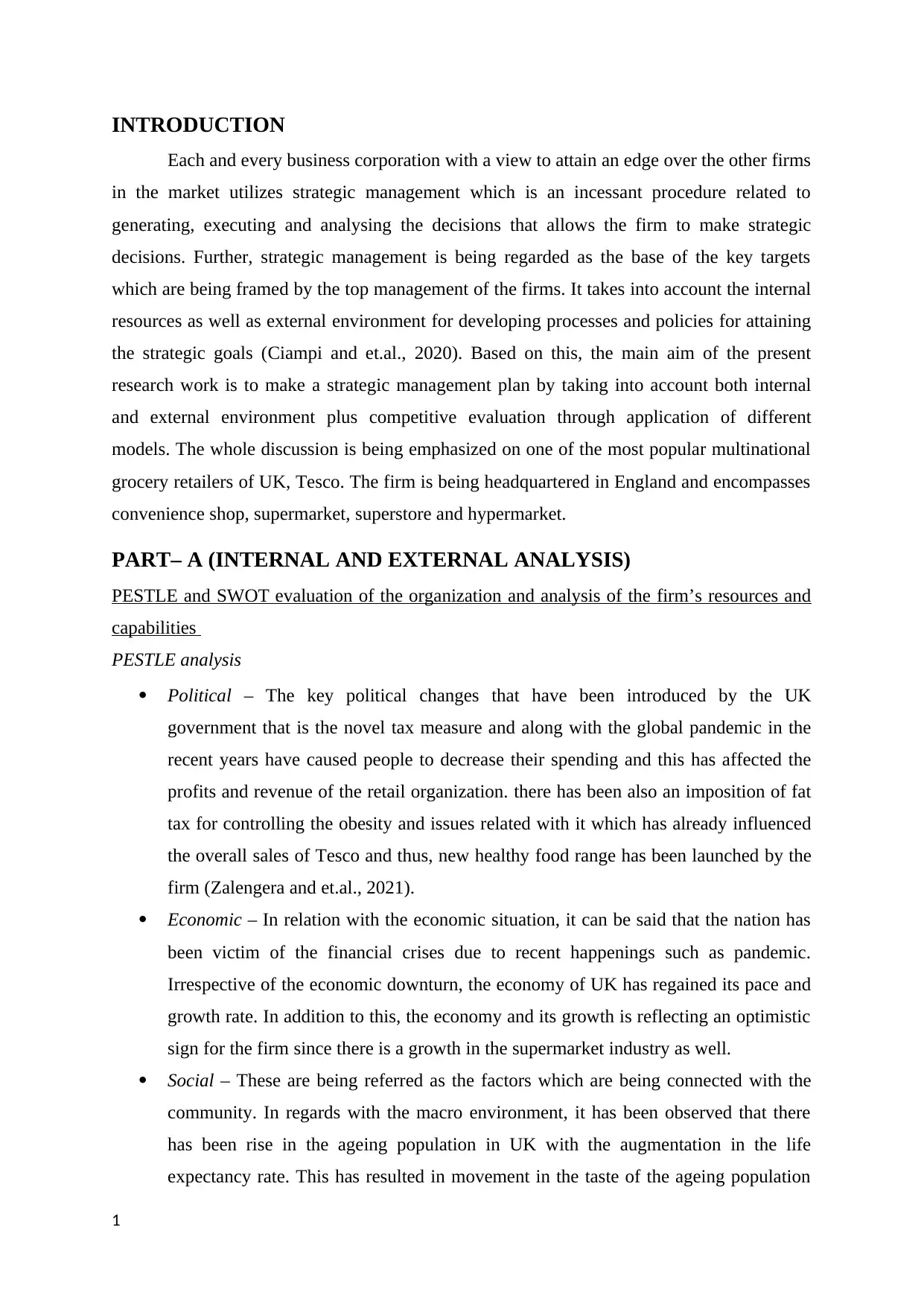
INTRODUCTION
Each and every business corporation with a view to attain an edge over the other firms
in the market utilizes strategic management which is an incessant procedure related to
generating, executing and analysing the decisions that allows the firm to make strategic
decisions. Further, strategic management is being regarded as the base of the key targets
which are being framed by the top management of the firms. It takes into account the internal
resources as well as external environment for developing processes and policies for attaining
the strategic goals (Ciampi and et.al., 2020). Based on this, the main aim of the present
research work is to make a strategic management plan by taking into account both internal
and external environment plus competitive evaluation through application of different
models. The whole discussion is being emphasized on one of the most popular multinational
grocery retailers of UK, Tesco. The firm is being headquartered in England and encompasses
convenience shop, supermarket, superstore and hypermarket.
PART– A (INTERNAL AND EXTERNAL ANALYSIS)
PESTLE and SWOT evaluation of the organization and analysis of the firm’s resources and
capabilities
PESTLE analysis
Political – The key political changes that have been introduced by the UK
government that is the novel tax measure and along with the global pandemic in the
recent years have caused people to decrease their spending and this has affected the
profits and revenue of the retail organization. there has been also an imposition of fat
tax for controlling the obesity and issues related with it which has already influenced
the overall sales of Tesco and thus, new healthy food range has been launched by the
firm (Zalengera and et.al., 2021).
Economic – In relation with the economic situation, it can be said that the nation has
been victim of the financial crises due to recent happenings such as pandemic.
Irrespective of the economic downturn, the economy of UK has regained its pace and
growth rate. In addition to this, the economy and its growth is reflecting an optimistic
sign for the firm since there is a growth in the supermarket industry as well.
Social – These are being referred as the factors which are being connected with the
community. In regards with the macro environment, it has been observed that there
has been rise in the ageing population in UK with the augmentation in the life
expectancy rate. This has resulted in movement in the taste of the ageing population
1
Each and every business corporation with a view to attain an edge over the other firms
in the market utilizes strategic management which is an incessant procedure related to
generating, executing and analysing the decisions that allows the firm to make strategic
decisions. Further, strategic management is being regarded as the base of the key targets
which are being framed by the top management of the firms. It takes into account the internal
resources as well as external environment for developing processes and policies for attaining
the strategic goals (Ciampi and et.al., 2020). Based on this, the main aim of the present
research work is to make a strategic management plan by taking into account both internal
and external environment plus competitive evaluation through application of different
models. The whole discussion is being emphasized on one of the most popular multinational
grocery retailers of UK, Tesco. The firm is being headquartered in England and encompasses
convenience shop, supermarket, superstore and hypermarket.
PART– A (INTERNAL AND EXTERNAL ANALYSIS)
PESTLE and SWOT evaluation of the organization and analysis of the firm’s resources and
capabilities
PESTLE analysis
Political – The key political changes that have been introduced by the UK
government that is the novel tax measure and along with the global pandemic in the
recent years have caused people to decrease their spending and this has affected the
profits and revenue of the retail organization. there has been also an imposition of fat
tax for controlling the obesity and issues related with it which has already influenced
the overall sales of Tesco and thus, new healthy food range has been launched by the
firm (Zalengera and et.al., 2021).
Economic – In relation with the economic situation, it can be said that the nation has
been victim of the financial crises due to recent happenings such as pandemic.
Irrespective of the economic downturn, the economy of UK has regained its pace and
growth rate. In addition to this, the economy and its growth is reflecting an optimistic
sign for the firm since there is a growth in the supermarket industry as well.
Social – These are being referred as the factors which are being connected with the
community. In regards with the macro environment, it has been observed that there
has been rise in the ageing population in UK with the augmentation in the life
expectancy rate. This has resulted in movement in the taste of the ageing population
1
Paraphrase This Document
Need a fresh take? Get an instant paraphrase of this document with our AI Paraphraser
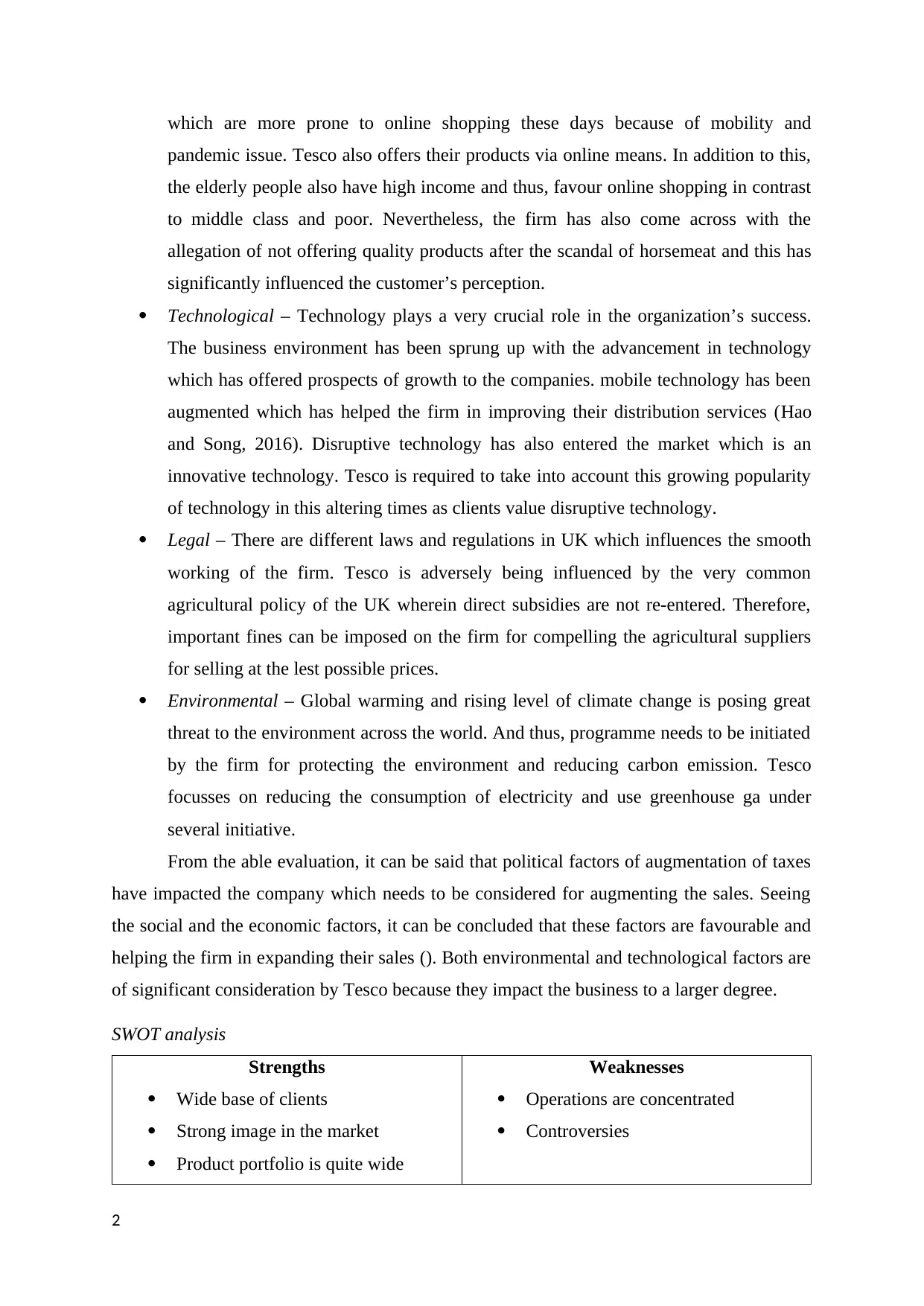
which are more prone to online shopping these days because of mobility and
pandemic issue. Tesco also offers their products via online means. In addition to this,
the elderly people also have high income and thus, favour online shopping in contrast
to middle class and poor. Nevertheless, the firm has also come across with the
allegation of not offering quality products after the scandal of horsemeat and this has
significantly influenced the customer’s perception.
Technological – Technology plays a very crucial role in the organization’s success.
The business environment has been sprung up with the advancement in technology
which has offered prospects of growth to the companies. mobile technology has been
augmented which has helped the firm in improving their distribution services (Hao
and Song, 2016). Disruptive technology has also entered the market which is an
innovative technology. Tesco is required to take into account this growing popularity
of technology in this altering times as clients value disruptive technology.
Legal – There are different laws and regulations in UK which influences the smooth
working of the firm. Tesco is adversely being influenced by the very common
agricultural policy of the UK wherein direct subsidies are not re-entered. Therefore,
important fines can be imposed on the firm for compelling the agricultural suppliers
for selling at the lest possible prices.
Environmental – Global warming and rising level of climate change is posing great
threat to the environment across the world. And thus, programme needs to be initiated
by the firm for protecting the environment and reducing carbon emission. Tesco
focusses on reducing the consumption of electricity and use greenhouse ga under
several initiative.
From the able evaluation, it can be said that political factors of augmentation of taxes
have impacted the company which needs to be considered for augmenting the sales. Seeing
the social and the economic factors, it can be concluded that these factors are favourable and
helping the firm in expanding their sales (). Both environmental and technological factors are
of significant consideration by Tesco because they impact the business to a larger degree.
SWOT analysis
Strengths
Wide base of clients
Strong image in the market
Product portfolio is quite wide
Weaknesses
Operations are concentrated
Controversies
2
pandemic issue. Tesco also offers their products via online means. In addition to this,
the elderly people also have high income and thus, favour online shopping in contrast
to middle class and poor. Nevertheless, the firm has also come across with the
allegation of not offering quality products after the scandal of horsemeat and this has
significantly influenced the customer’s perception.
Technological – Technology plays a very crucial role in the organization’s success.
The business environment has been sprung up with the advancement in technology
which has offered prospects of growth to the companies. mobile technology has been
augmented which has helped the firm in improving their distribution services (Hao
and Song, 2016). Disruptive technology has also entered the market which is an
innovative technology. Tesco is required to take into account this growing popularity
of technology in this altering times as clients value disruptive technology.
Legal – There are different laws and regulations in UK which influences the smooth
working of the firm. Tesco is adversely being influenced by the very common
agricultural policy of the UK wherein direct subsidies are not re-entered. Therefore,
important fines can be imposed on the firm for compelling the agricultural suppliers
for selling at the lest possible prices.
Environmental – Global warming and rising level of climate change is posing great
threat to the environment across the world. And thus, programme needs to be initiated
by the firm for protecting the environment and reducing carbon emission. Tesco
focusses on reducing the consumption of electricity and use greenhouse ga under
several initiative.
From the able evaluation, it can be said that political factors of augmentation of taxes
have impacted the company which needs to be considered for augmenting the sales. Seeing
the social and the economic factors, it can be concluded that these factors are favourable and
helping the firm in expanding their sales (). Both environmental and technological factors are
of significant consideration by Tesco because they impact the business to a larger degree.
SWOT analysis
Strengths
Wide base of clients
Strong image in the market
Product portfolio is quite wide
Weaknesses
Operations are concentrated
Controversies
2
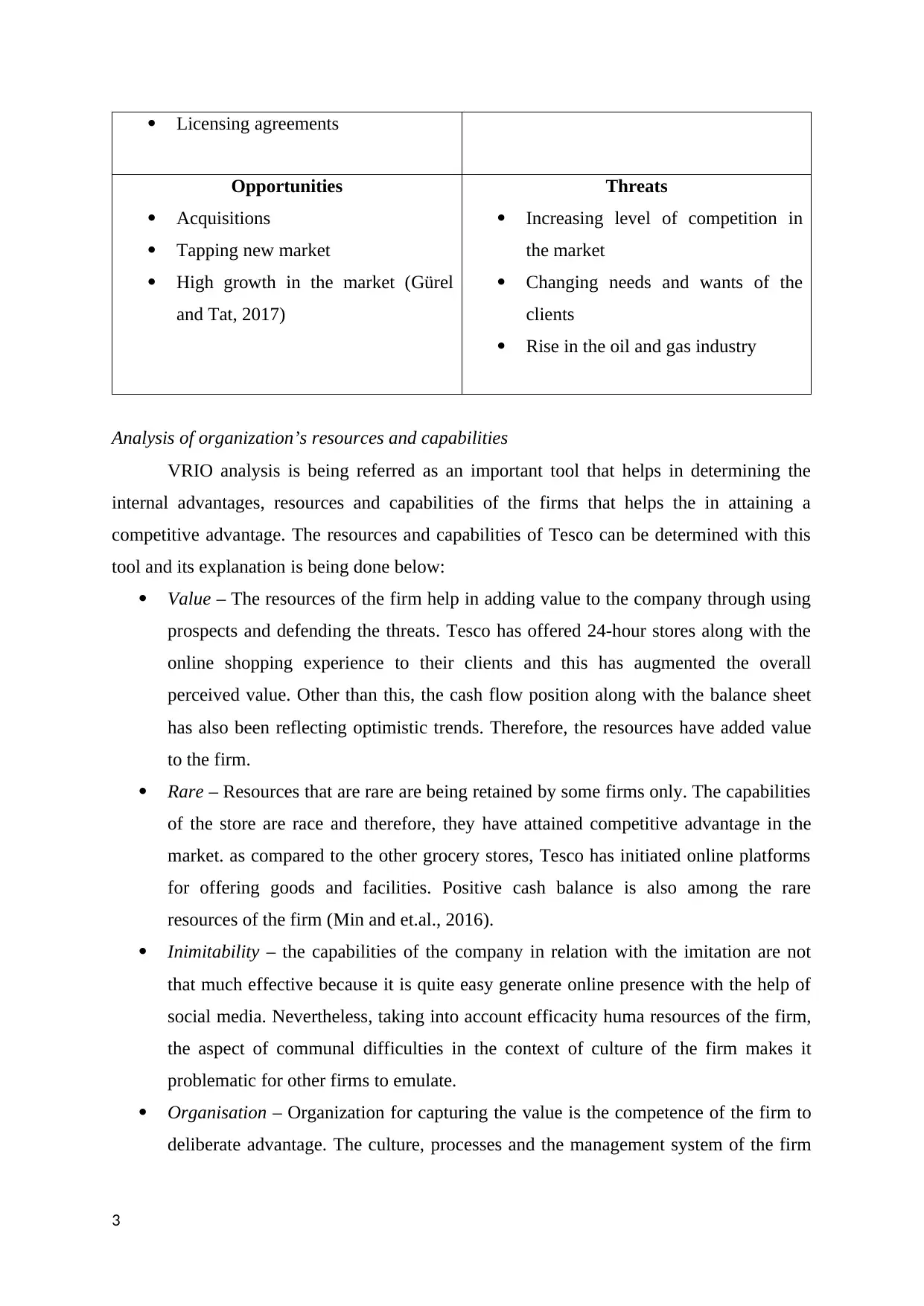
Licensing agreements
Opportunities
Acquisitions
Tapping new market
High growth in the market (Gürel
and Tat, 2017)
Threats
Increasing level of competition in
the market
Changing needs and wants of the
clients
Rise in the oil and gas industry
Analysis of organization’s resources and capabilities
VRIO analysis is being referred as an important tool that helps in determining the
internal advantages, resources and capabilities of the firms that helps the in attaining a
competitive advantage. The resources and capabilities of Tesco can be determined with this
tool and its explanation is being done below:
Value – The resources of the firm help in adding value to the company through using
prospects and defending the threats. Tesco has offered 24-hour stores along with the
online shopping experience to their clients and this has augmented the overall
perceived value. Other than this, the cash flow position along with the balance sheet
has also been reflecting optimistic trends. Therefore, the resources have added value
to the firm.
Rare – Resources that are rare are being retained by some firms only. The capabilities
of the store are race and therefore, they have attained competitive advantage in the
market. as compared to the other grocery stores, Tesco has initiated online platforms
for offering goods and facilities. Positive cash balance is also among the rare
resources of the firm (Min and et.al., 2016).
Inimitability – the capabilities of the company in relation with the imitation are not
that much effective because it is quite easy generate online presence with the help of
social media. Nevertheless, taking into account efficacity huma resources of the firm,
the aspect of communal difficulties in the context of culture of the firm makes it
problematic for other firms to emulate.
Organisation – Organization for capturing the value is the competence of the firm to
deliberate advantage. The culture, processes and the management system of the firm
3
Opportunities
Acquisitions
Tapping new market
High growth in the market (Gürel
and Tat, 2017)
Threats
Increasing level of competition in
the market
Changing needs and wants of the
clients
Rise in the oil and gas industry
Analysis of organization’s resources and capabilities
VRIO analysis is being referred as an important tool that helps in determining the
internal advantages, resources and capabilities of the firms that helps the in attaining a
competitive advantage. The resources and capabilities of Tesco can be determined with this
tool and its explanation is being done below:
Value – The resources of the firm help in adding value to the company through using
prospects and defending the threats. Tesco has offered 24-hour stores along with the
online shopping experience to their clients and this has augmented the overall
perceived value. Other than this, the cash flow position along with the balance sheet
has also been reflecting optimistic trends. Therefore, the resources have added value
to the firm.
Rare – Resources that are rare are being retained by some firms only. The capabilities
of the store are race and therefore, they have attained competitive advantage in the
market. as compared to the other grocery stores, Tesco has initiated online platforms
for offering goods and facilities. Positive cash balance is also among the rare
resources of the firm (Min and et.al., 2016).
Inimitability – the capabilities of the company in relation with the imitation are not
that much effective because it is quite easy generate online presence with the help of
social media. Nevertheless, taking into account efficacity huma resources of the firm,
the aspect of communal difficulties in the context of culture of the firm makes it
problematic for other firms to emulate.
Organisation – Organization for capturing the value is the competence of the firm to
deliberate advantage. The culture, processes and the management system of the firm
3
⊘ This is a preview!⊘
Do you want full access?
Subscribe today to unlock all pages.

Trusted by 1+ million students worldwide
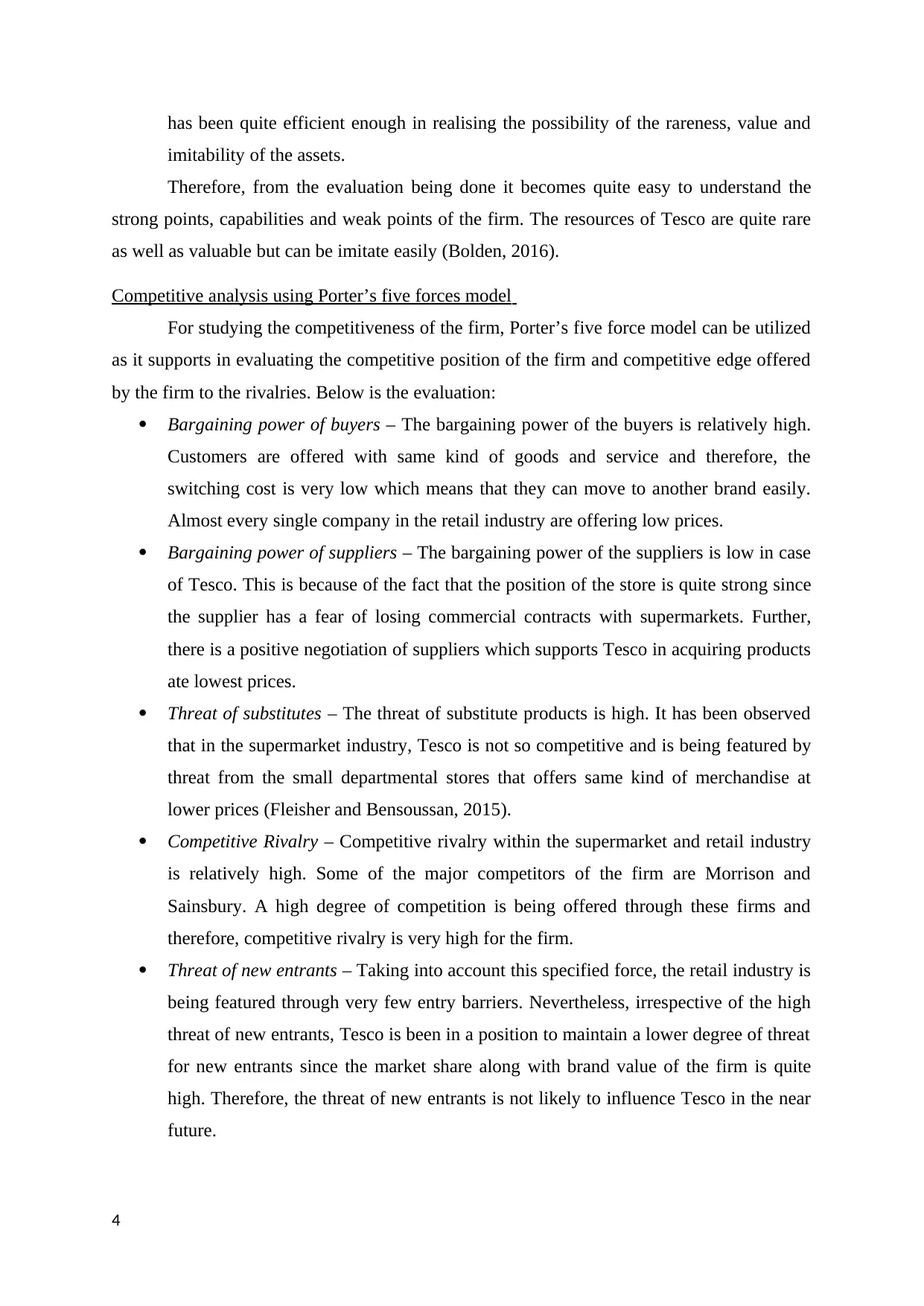
has been quite efficient enough in realising the possibility of the rareness, value and
imitability of the assets.
Therefore, from the evaluation being done it becomes quite easy to understand the
strong points, capabilities and weak points of the firm. The resources of Tesco are quite rare
as well as valuable but can be imitate easily (Bolden, 2016).
Competitive analysis using Porter’s five forces model
For studying the competitiveness of the firm, Porter’s five force model can be utilized
as it supports in evaluating the competitive position of the firm and competitive edge offered
by the firm to the rivalries. Below is the evaluation:
Bargaining power of buyers – The bargaining power of the buyers is relatively high.
Customers are offered with same kind of goods and service and therefore, the
switching cost is very low which means that they can move to another brand easily.
Almost every single company in the retail industry are offering low prices.
Bargaining power of suppliers – The bargaining power of the suppliers is low in case
of Tesco. This is because of the fact that the position of the store is quite strong since
the supplier has a fear of losing commercial contracts with supermarkets. Further,
there is a positive negotiation of suppliers which supports Tesco in acquiring products
ate lowest prices.
Threat of substitutes – The threat of substitute products is high. It has been observed
that in the supermarket industry, Tesco is not so competitive and is being featured by
threat from the small departmental stores that offers same kind of merchandise at
lower prices (Fleisher and Bensoussan, 2015).
Competitive Rivalry – Competitive rivalry within the supermarket and retail industry
is relatively high. Some of the major competitors of the firm are Morrison and
Sainsbury. A high degree of competition is being offered through these firms and
therefore, competitive rivalry is very high for the firm.
Threat of new entrants – Taking into account this specified force, the retail industry is
being featured through very few entry barriers. Nevertheless, irrespective of the high
threat of new entrants, Tesco is been in a position to maintain a lower degree of threat
for new entrants since the market share along with brand value of the firm is quite
high. Therefore, the threat of new entrants is not likely to influence Tesco in the near
future.
4
imitability of the assets.
Therefore, from the evaluation being done it becomes quite easy to understand the
strong points, capabilities and weak points of the firm. The resources of Tesco are quite rare
as well as valuable but can be imitate easily (Bolden, 2016).
Competitive analysis using Porter’s five forces model
For studying the competitiveness of the firm, Porter’s five force model can be utilized
as it supports in evaluating the competitive position of the firm and competitive edge offered
by the firm to the rivalries. Below is the evaluation:
Bargaining power of buyers – The bargaining power of the buyers is relatively high.
Customers are offered with same kind of goods and service and therefore, the
switching cost is very low which means that they can move to another brand easily.
Almost every single company in the retail industry are offering low prices.
Bargaining power of suppliers – The bargaining power of the suppliers is low in case
of Tesco. This is because of the fact that the position of the store is quite strong since
the supplier has a fear of losing commercial contracts with supermarkets. Further,
there is a positive negotiation of suppliers which supports Tesco in acquiring products
ate lowest prices.
Threat of substitutes – The threat of substitute products is high. It has been observed
that in the supermarket industry, Tesco is not so competitive and is being featured by
threat from the small departmental stores that offers same kind of merchandise at
lower prices (Fleisher and Bensoussan, 2015).
Competitive Rivalry – Competitive rivalry within the supermarket and retail industry
is relatively high. Some of the major competitors of the firm are Morrison and
Sainsbury. A high degree of competition is being offered through these firms and
therefore, competitive rivalry is very high for the firm.
Threat of new entrants – Taking into account this specified force, the retail industry is
being featured through very few entry barriers. Nevertheless, irrespective of the high
threat of new entrants, Tesco is been in a position to maintain a lower degree of threat
for new entrants since the market share along with brand value of the firm is quite
high. Therefore, the threat of new entrants is not likely to influence Tesco in the near
future.
4
Paraphrase This Document
Need a fresh take? Get an instant paraphrase of this document with our AI Paraphraser
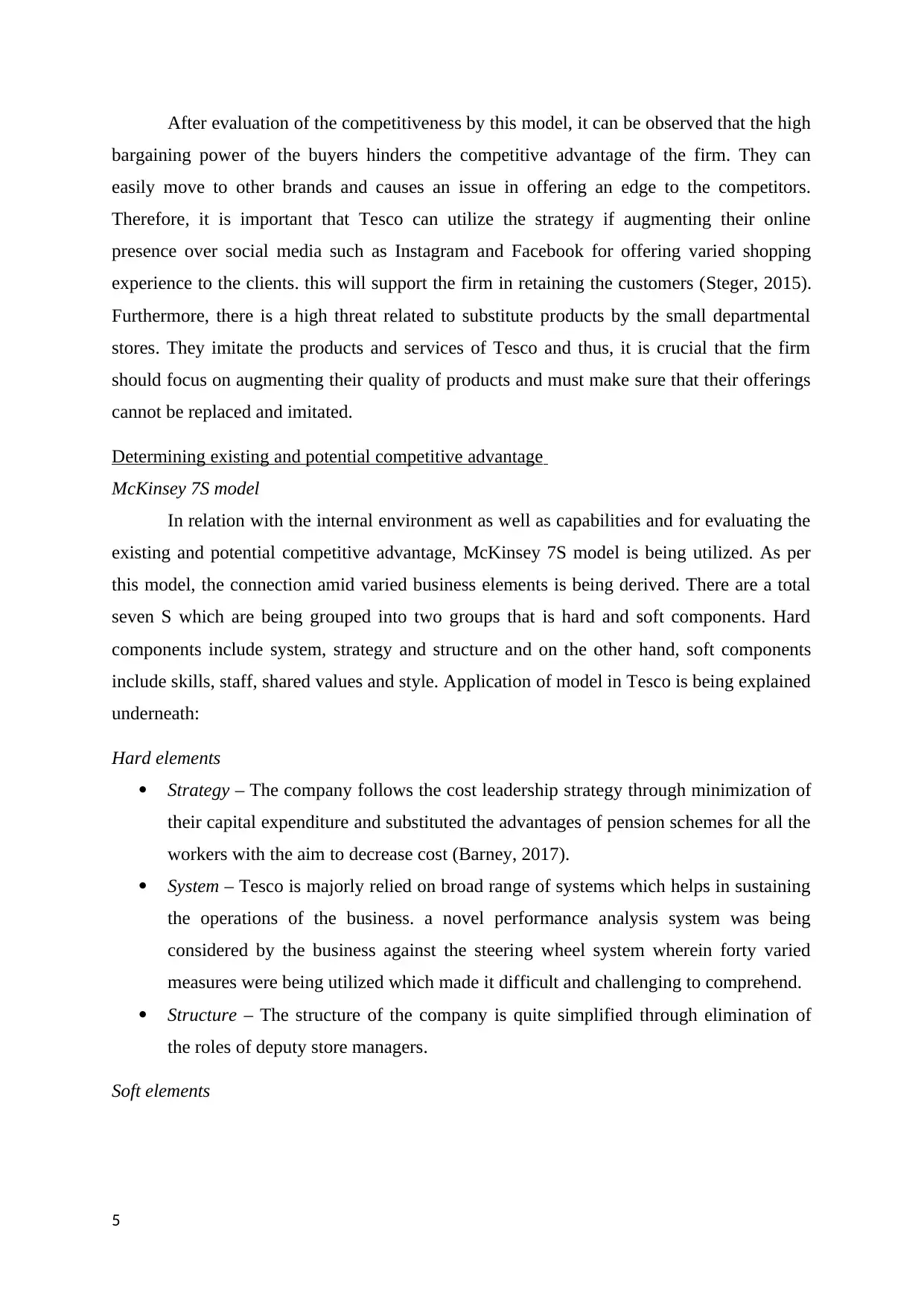
After evaluation of the competitiveness by this model, it can be observed that the high
bargaining power of the buyers hinders the competitive advantage of the firm. They can
easily move to other brands and causes an issue in offering an edge to the competitors.
Therefore, it is important that Tesco can utilize the strategy if augmenting their online
presence over social media such as Instagram and Facebook for offering varied shopping
experience to the clients. this will support the firm in retaining the customers (Steger, 2015).
Furthermore, there is a high threat related to substitute products by the small departmental
stores. They imitate the products and services of Tesco and thus, it is crucial that the firm
should focus on augmenting their quality of products and must make sure that their offerings
cannot be replaced and imitated.
Determining existing and potential competitive advantage
McKinsey 7S model
In relation with the internal environment as well as capabilities and for evaluating the
existing and potential competitive advantage, McKinsey 7S model is being utilized. As per
this model, the connection amid varied business elements is being derived. There are a total
seven S which are being grouped into two groups that is hard and soft components. Hard
components include system, strategy and structure and on the other hand, soft components
include skills, staff, shared values and style. Application of model in Tesco is being explained
underneath:
Hard elements
Strategy – The company follows the cost leadership strategy through minimization of
their capital expenditure and substituted the advantages of pension schemes for all the
workers with the aim to decrease cost (Barney, 2017).
System – Tesco is majorly relied on broad range of systems which helps in sustaining
the operations of the business. a novel performance analysis system was being
considered by the business against the steering wheel system wherein forty varied
measures were being utilized which made it difficult and challenging to comprehend.
Structure – The structure of the company is quite simplified through elimination of
the roles of deputy store managers.
Soft elements
5
bargaining power of the buyers hinders the competitive advantage of the firm. They can
easily move to other brands and causes an issue in offering an edge to the competitors.
Therefore, it is important that Tesco can utilize the strategy if augmenting their online
presence over social media such as Instagram and Facebook for offering varied shopping
experience to the clients. this will support the firm in retaining the customers (Steger, 2015).
Furthermore, there is a high threat related to substitute products by the small departmental
stores. They imitate the products and services of Tesco and thus, it is crucial that the firm
should focus on augmenting their quality of products and must make sure that their offerings
cannot be replaced and imitated.
Determining existing and potential competitive advantage
McKinsey 7S model
In relation with the internal environment as well as capabilities and for evaluating the
existing and potential competitive advantage, McKinsey 7S model is being utilized. As per
this model, the connection amid varied business elements is being derived. There are a total
seven S which are being grouped into two groups that is hard and soft components. Hard
components include system, strategy and structure and on the other hand, soft components
include skills, staff, shared values and style. Application of model in Tesco is being explained
underneath:
Hard elements
Strategy – The company follows the cost leadership strategy through minimization of
their capital expenditure and substituted the advantages of pension schemes for all the
workers with the aim to decrease cost (Barney, 2017).
System – Tesco is majorly relied on broad range of systems which helps in sustaining
the operations of the business. a novel performance analysis system was being
considered by the business against the steering wheel system wherein forty varied
measures were being utilized which made it difficult and challenging to comprehend.
Structure – The structure of the company is quite simplified through elimination of
the roles of deputy store managers.
Soft elements
5
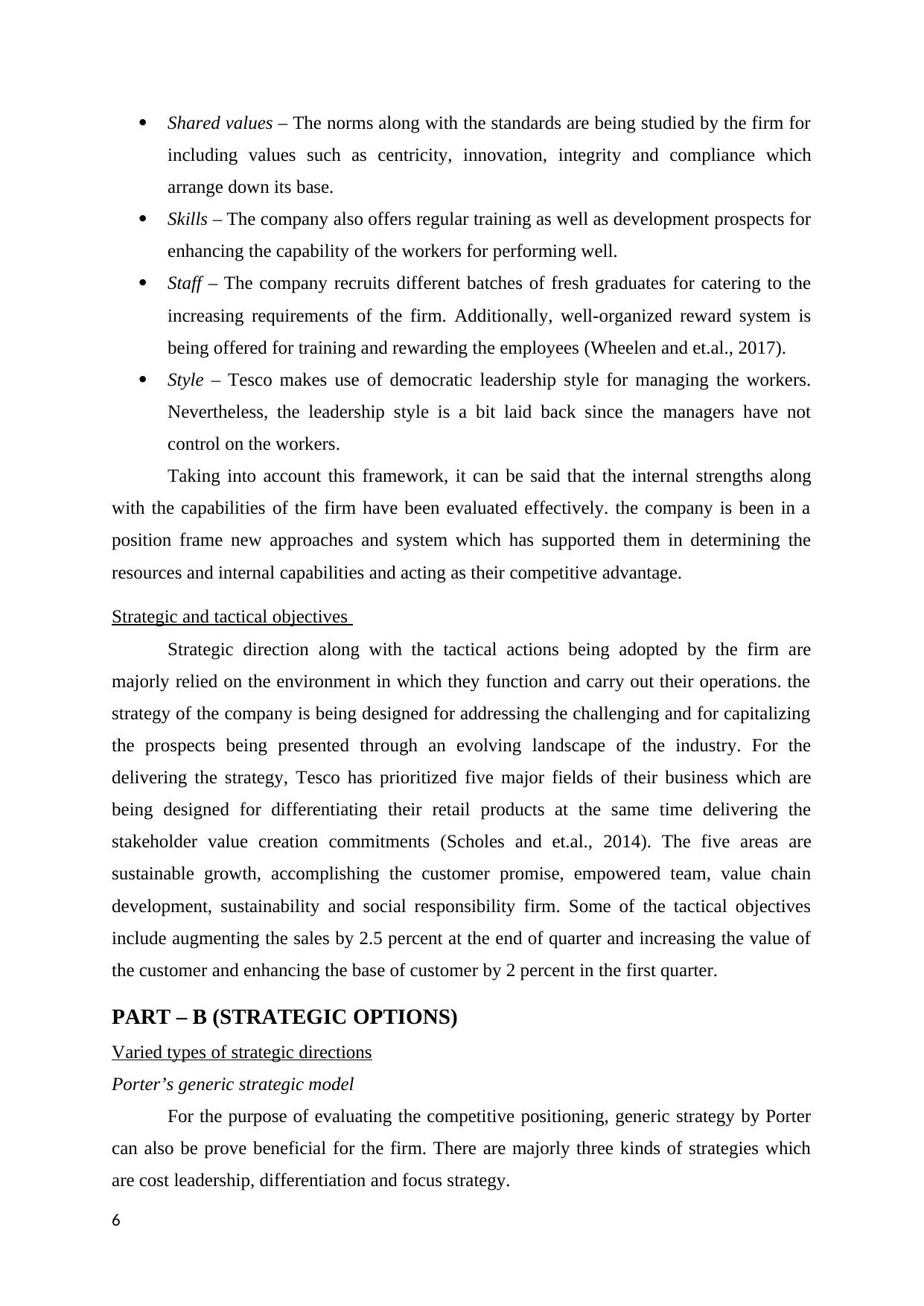
Shared values – The norms along with the standards are being studied by the firm for
including values such as centricity, innovation, integrity and compliance which
arrange down its base.
Skills – The company also offers regular training as well as development prospects for
enhancing the capability of the workers for performing well.
Staff – The company recruits different batches of fresh graduates for catering to the
increasing requirements of the firm. Additionally, well-organized reward system is
being offered for training and rewarding the employees (Wheelen and et.al., 2017).
Style – Tesco makes use of democratic leadership style for managing the workers.
Nevertheless, the leadership style is a bit laid back since the managers have not
control on the workers.
Taking into account this framework, it can be said that the internal strengths along
with the capabilities of the firm have been evaluated effectively. the company is been in a
position frame new approaches and system which has supported them in determining the
resources and internal capabilities and acting as their competitive advantage.
Strategic and tactical objectives
Strategic direction along with the tactical actions being adopted by the firm are
majorly relied on the environment in which they function and carry out their operations. the
strategy of the company is being designed for addressing the challenging and for capitalizing
the prospects being presented through an evolving landscape of the industry. For the
delivering the strategy, Tesco has prioritized five major fields of their business which are
being designed for differentiating their retail products at the same time delivering the
stakeholder value creation commitments (Scholes and et.al., 2014). The five areas are
sustainable growth, accomplishing the customer promise, empowered team, value chain
development, sustainability and social responsibility firm. Some of the tactical objectives
include augmenting the sales by 2.5 percent at the end of quarter and increasing the value of
the customer and enhancing the base of customer by 2 percent in the first quarter.
PART – B (STRATEGIC OPTIONS)
Varied types of strategic directions
Porter’s generic strategic model
For the purpose of evaluating the competitive positioning, generic strategy by Porter
can also be prove beneficial for the firm. There are majorly three kinds of strategies which
are cost leadership, differentiation and focus strategy.
6
including values such as centricity, innovation, integrity and compliance which
arrange down its base.
Skills – The company also offers regular training as well as development prospects for
enhancing the capability of the workers for performing well.
Staff – The company recruits different batches of fresh graduates for catering to the
increasing requirements of the firm. Additionally, well-organized reward system is
being offered for training and rewarding the employees (Wheelen and et.al., 2017).
Style – Tesco makes use of democratic leadership style for managing the workers.
Nevertheless, the leadership style is a bit laid back since the managers have not
control on the workers.
Taking into account this framework, it can be said that the internal strengths along
with the capabilities of the firm have been evaluated effectively. the company is been in a
position frame new approaches and system which has supported them in determining the
resources and internal capabilities and acting as their competitive advantage.
Strategic and tactical objectives
Strategic direction along with the tactical actions being adopted by the firm are
majorly relied on the environment in which they function and carry out their operations. the
strategy of the company is being designed for addressing the challenging and for capitalizing
the prospects being presented through an evolving landscape of the industry. For the
delivering the strategy, Tesco has prioritized five major fields of their business which are
being designed for differentiating their retail products at the same time delivering the
stakeholder value creation commitments (Scholes and et.al., 2014). The five areas are
sustainable growth, accomplishing the customer promise, empowered team, value chain
development, sustainability and social responsibility firm. Some of the tactical objectives
include augmenting the sales by 2.5 percent at the end of quarter and increasing the value of
the customer and enhancing the base of customer by 2 percent in the first quarter.
PART – B (STRATEGIC OPTIONS)
Varied types of strategic directions
Porter’s generic strategic model
For the purpose of evaluating the competitive positioning, generic strategy by Porter
can also be prove beneficial for the firm. There are majorly three kinds of strategies which
are cost leadership, differentiation and focus strategy.
6
⊘ This is a preview!⊘
Do you want full access?
Subscribe today to unlock all pages.

Trusted by 1+ million students worldwide
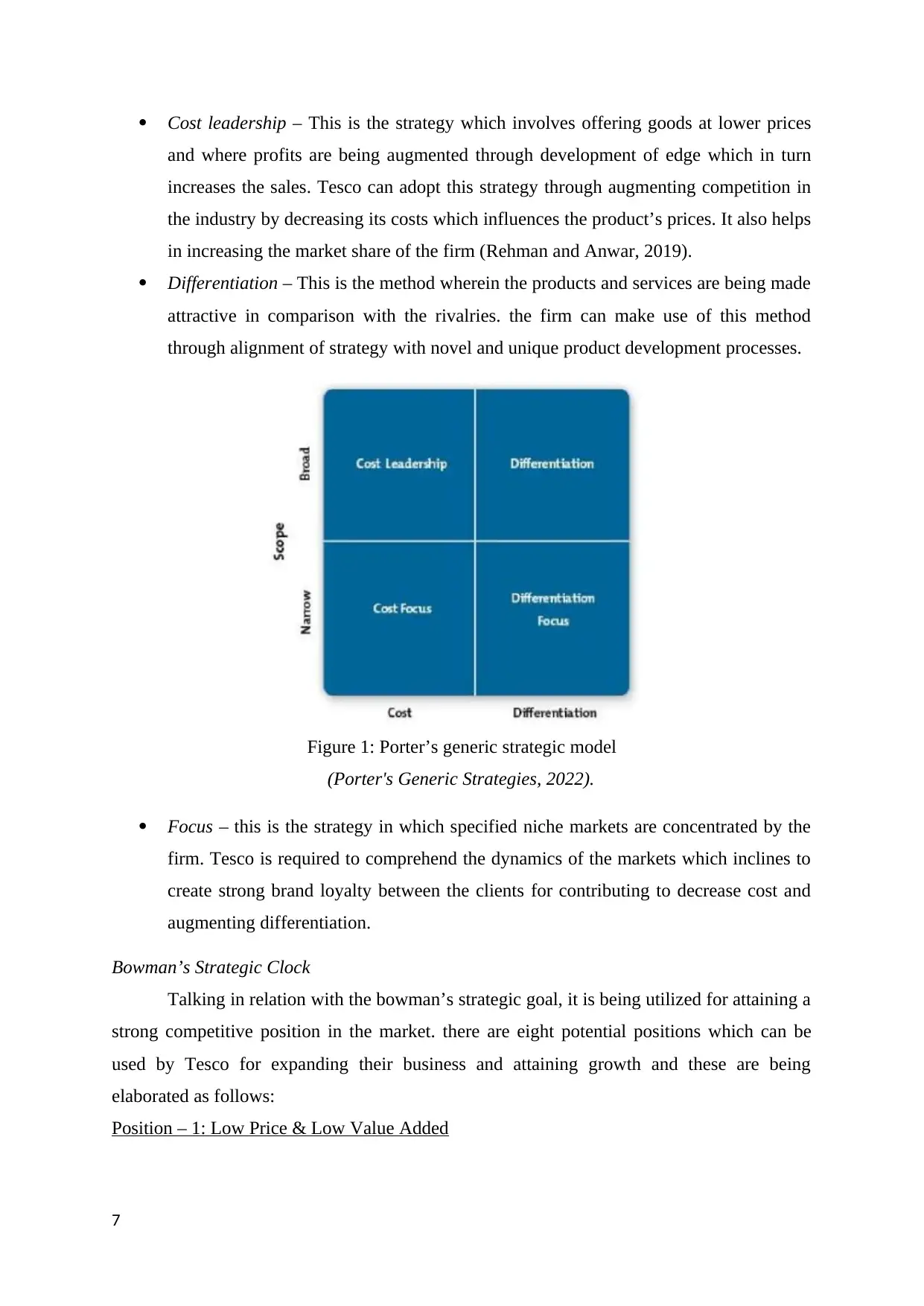
Cost leadership – This is the strategy which involves offering goods at lower prices
and where profits are being augmented through development of edge which in turn
increases the sales. Tesco can adopt this strategy through augmenting competition in
the industry by decreasing its costs which influences the product’s prices. It also helps
in increasing the market share of the firm (Rehman and Anwar, 2019).
Differentiation – This is the method wherein the products and services are being made
attractive in comparison with the rivalries. the firm can make use of this method
through alignment of strategy with novel and unique product development processes.
Figure 1: Porter’s generic strategic model
(Porter's Generic Strategies, 2022).
Focus – this is the strategy in which specified niche markets are concentrated by the
firm. Tesco is required to comprehend the dynamics of the markets which inclines to
create strong brand loyalty between the clients for contributing to decrease cost and
augmenting differentiation.
Bowman’s Strategic Clock
Talking in relation with the bowman’s strategic goal, it is being utilized for attaining a
strong competitive position in the market. there are eight potential positions which can be
used by Tesco for expanding their business and attaining growth and these are being
elaborated as follows:
Position – 1: Low Price & Low Value Added
7
and where profits are being augmented through development of edge which in turn
increases the sales. Tesco can adopt this strategy through augmenting competition in
the industry by decreasing its costs which influences the product’s prices. It also helps
in increasing the market share of the firm (Rehman and Anwar, 2019).
Differentiation – This is the method wherein the products and services are being made
attractive in comparison with the rivalries. the firm can make use of this method
through alignment of strategy with novel and unique product development processes.
Figure 1: Porter’s generic strategic model
(Porter's Generic Strategies, 2022).
Focus – this is the strategy in which specified niche markets are concentrated by the
firm. Tesco is required to comprehend the dynamics of the markets which inclines to
create strong brand loyalty between the clients for contributing to decrease cost and
augmenting differentiation.
Bowman’s Strategic Clock
Talking in relation with the bowman’s strategic goal, it is being utilized for attaining a
strong competitive position in the market. there are eight potential positions which can be
used by Tesco for expanding their business and attaining growth and these are being
elaborated as follows:
Position – 1: Low Price & Low Value Added
7
Paraphrase This Document
Need a fresh take? Get an instant paraphrase of this document with our AI Paraphraser
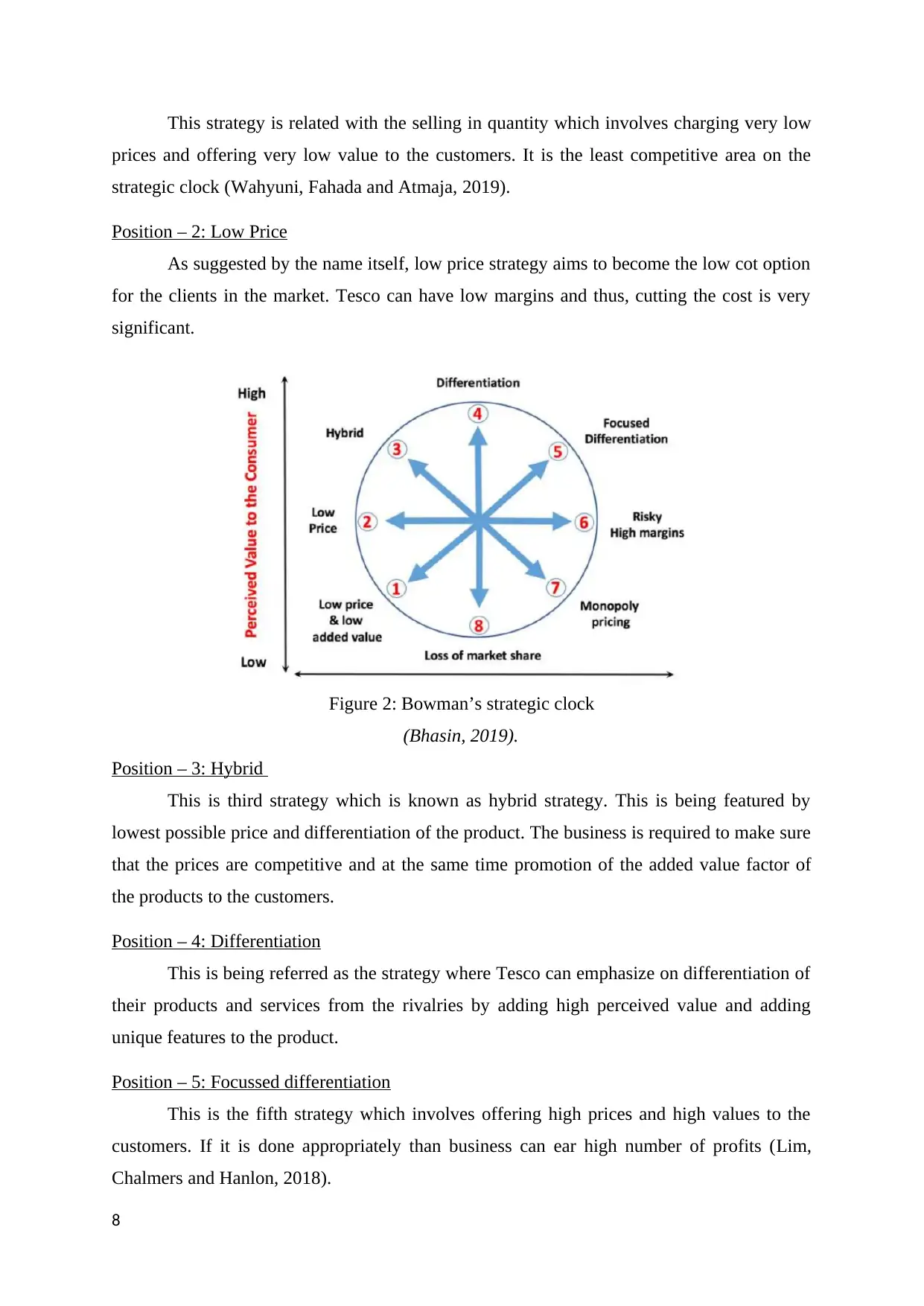
This strategy is related with the selling in quantity which involves charging very low
prices and offering very low value to the customers. It is the least competitive area on the
strategic clock (Wahyuni, Fahada and Atmaja, 2019).
Position – 2: Low Price
As suggested by the name itself, low price strategy aims to become the low cot option
for the clients in the market. Tesco can have low margins and thus, cutting the cost is very
significant.
Figure 2: Bowman’s strategic clock
(Bhasin, 2019).
Position – 3: Hybrid
This is third strategy which is known as hybrid strategy. This is being featured by
lowest possible price and differentiation of the product. The business is required to make sure
that the prices are competitive and at the same time promotion of the added value factor of
the products to the customers.
Position – 4: Differentiation
This is being referred as the strategy where Tesco can emphasize on differentiation of
their products and services from the rivalries by adding high perceived value and adding
unique features to the product.
Position – 5: Focussed differentiation
This is the fifth strategy which involves offering high prices and high values to the
customers. If it is done appropriately than business can ear high number of profits (Lim,
Chalmers and Hanlon, 2018).
8
prices and offering very low value to the customers. It is the least competitive area on the
strategic clock (Wahyuni, Fahada and Atmaja, 2019).
Position – 2: Low Price
As suggested by the name itself, low price strategy aims to become the low cot option
for the clients in the market. Tesco can have low margins and thus, cutting the cost is very
significant.
Figure 2: Bowman’s strategic clock
(Bhasin, 2019).
Position – 3: Hybrid
This is third strategy which is known as hybrid strategy. This is being featured by
lowest possible price and differentiation of the product. The business is required to make sure
that the prices are competitive and at the same time promotion of the added value factor of
the products to the customers.
Position – 4: Differentiation
This is being referred as the strategy where Tesco can emphasize on differentiation of
their products and services from the rivalries by adding high perceived value and adding
unique features to the product.
Position – 5: Focussed differentiation
This is the fifth strategy which involves offering high prices and high values to the
customers. If it is done appropriately than business can ear high number of profits (Lim,
Chalmers and Hanlon, 2018).
8
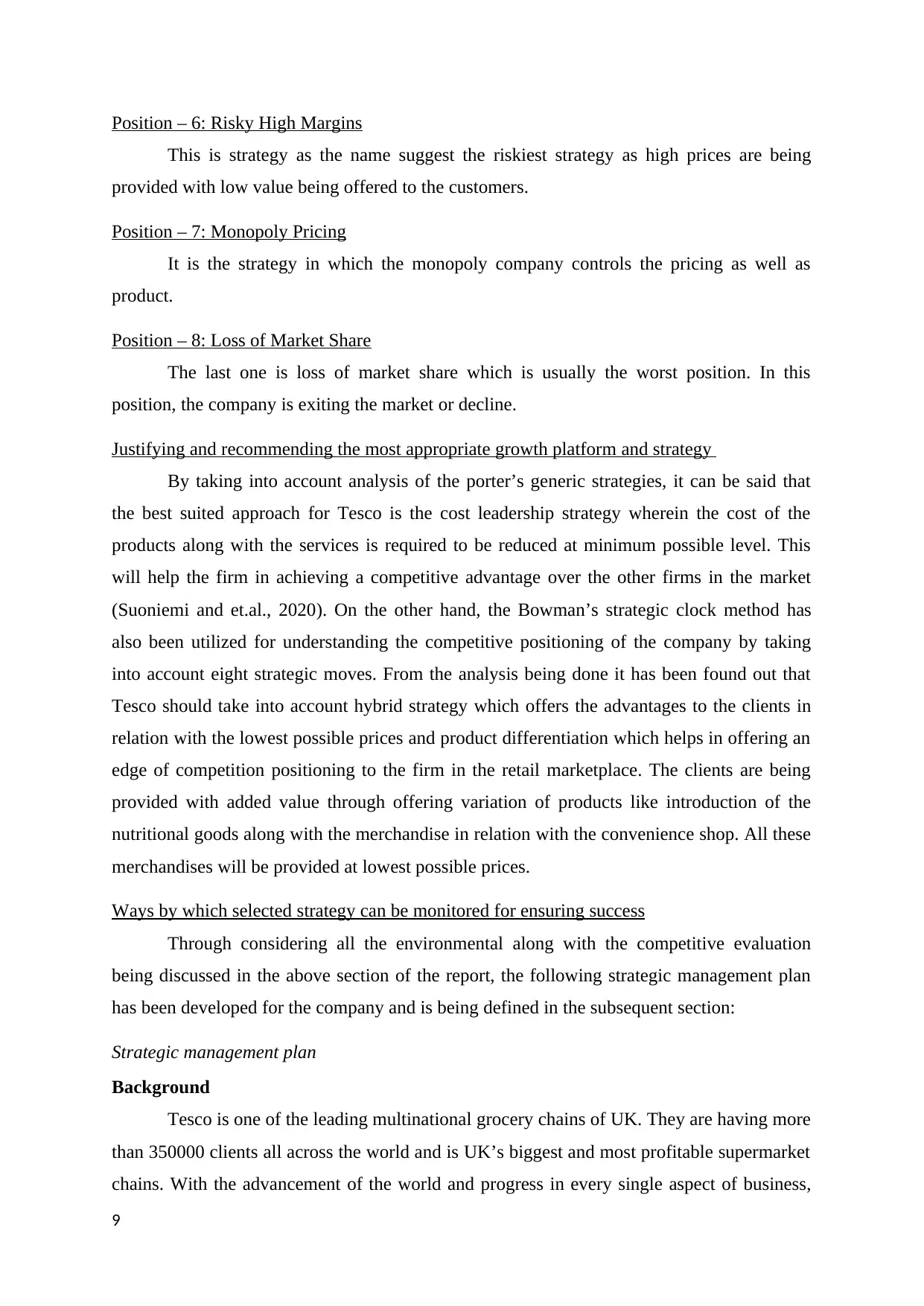
Position – 6: Risky High Margins
This is strategy as the name suggest the riskiest strategy as high prices are being
provided with low value being offered to the customers.
Position – 7: Monopoly Pricing
It is the strategy in which the monopoly company controls the pricing as well as
product.
Position – 8: Loss of Market Share
The last one is loss of market share which is usually the worst position. In this
position, the company is exiting the market or decline.
Justifying and recommending the most appropriate growth platform and strategy
By taking into account analysis of the porter’s generic strategies, it can be said that
the best suited approach for Tesco is the cost leadership strategy wherein the cost of the
products along with the services is required to be reduced at minimum possible level. This
will help the firm in achieving a competitive advantage over the other firms in the market
(Suoniemi and et.al., 2020). On the other hand, the Bowman’s strategic clock method has
also been utilized for understanding the competitive positioning of the company by taking
into account eight strategic moves. From the analysis being done it has been found out that
Tesco should take into account hybrid strategy which offers the advantages to the clients in
relation with the lowest possible prices and product differentiation which helps in offering an
edge of competition positioning to the firm in the retail marketplace. The clients are being
provided with added value through offering variation of products like introduction of the
nutritional goods along with the merchandise in relation with the convenience shop. All these
merchandises will be provided at lowest possible prices.
Ways by which selected strategy can be monitored for ensuring success
Through considering all the environmental along with the competitive evaluation
being discussed in the above section of the report, the following strategic management plan
has been developed for the company and is being defined in the subsequent section:
Strategic management plan
Background
Tesco is one of the leading multinational grocery chains of UK. They are having more
than 350000 clients all across the world and is UK’s biggest and most profitable supermarket
chains. With the advancement of the world and progress in every single aspect of business,
9
This is strategy as the name suggest the riskiest strategy as high prices are being
provided with low value being offered to the customers.
Position – 7: Monopoly Pricing
It is the strategy in which the monopoly company controls the pricing as well as
product.
Position – 8: Loss of Market Share
The last one is loss of market share which is usually the worst position. In this
position, the company is exiting the market or decline.
Justifying and recommending the most appropriate growth platform and strategy
By taking into account analysis of the porter’s generic strategies, it can be said that
the best suited approach for Tesco is the cost leadership strategy wherein the cost of the
products along with the services is required to be reduced at minimum possible level. This
will help the firm in achieving a competitive advantage over the other firms in the market
(Suoniemi and et.al., 2020). On the other hand, the Bowman’s strategic clock method has
also been utilized for understanding the competitive positioning of the company by taking
into account eight strategic moves. From the analysis being done it has been found out that
Tesco should take into account hybrid strategy which offers the advantages to the clients in
relation with the lowest possible prices and product differentiation which helps in offering an
edge of competition positioning to the firm in the retail marketplace. The clients are being
provided with added value through offering variation of products like introduction of the
nutritional goods along with the merchandise in relation with the convenience shop. All these
merchandises will be provided at lowest possible prices.
Ways by which selected strategy can be monitored for ensuring success
Through considering all the environmental along with the competitive evaluation
being discussed in the above section of the report, the following strategic management plan
has been developed for the company and is being defined in the subsequent section:
Strategic management plan
Background
Tesco is one of the leading multinational grocery chains of UK. They are having more
than 350000 clients all across the world and is UK’s biggest and most profitable supermarket
chains. With the advancement of the world and progress in every single aspect of business,
9
⊘ This is a preview!⊘
Do you want full access?
Subscribe today to unlock all pages.

Trusted by 1+ million students worldwide
1 out of 16
Related Documents
Your All-in-One AI-Powered Toolkit for Academic Success.
+13062052269
info@desklib.com
Available 24*7 on WhatsApp / Email
![[object Object]](/_next/static/media/star-bottom.7253800d.svg)
Unlock your academic potential
Copyright © 2020–2025 A2Z Services. All Rights Reserved. Developed and managed by ZUCOL.



